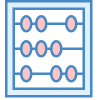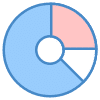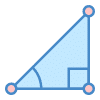Mathematics
The science that deals with the logic of shape, quantity and arrangement
Essential to everyday life, critical to science, technology and engineering, and necessary for many forms of employment

Mathematics
Key Stage 1
At each Key Stage, your child will learn different maths-related topics when attending school. Here, we provide you with some details of what your child will learn as they progress through their academic years.
Year 1
Counting
- Counting up to 20 objects and beyond
- Counting forwards and backwards from 0 to 20, and then beyond
- Reading and writing numbers from 0 to 20, and beyond
- Counting on and back in twos, fives and tens
- Using a number line to put numbers in the correct order
- Recognising patterns in numbers
- Recognising odd and even numbers
- Estimating amounts of objects and then counting to check.
Calculating
- Learning simple addition and subtraction
- Recognising mathematical words and symbols
- Using money – paying and giving change
- Learning which pairs of numbers add up to 10 (number bonds)
- Doubling and halving
- Sharing objects out into groups.
Time
- Telling the time to the hour and half hour
- Putting the days of the week and months of the year in order.
Shapes
- Recognising, naming and describing common 2D and 3D shapes
- Using shapes to make patterns, models and pictures
- Using ICT to record and change shapes.
Handling data
- Using a diagram to sort objects into groups
- Collecting information and recording it using tables or pictures.
Measuring
- Measuring, weighing and comparing different objects
- Using different instruments for measuring, such as scales, jugs or metre sticks
- Recording their results using pictures and numbers.
Year 2
Counting and calculating
- Counting up to 100
- Putting the numbers one to 100 in the correct order
- Recognising sequences and patterns
- Adding and subtracting one- and two-digit numbers
- Doing simple mental maths
- Learning doubles and halves of numbers to ten
- Starting to use simple division and multiplication
- Adding and subtracting using money.
Number facts
- Reading and writing two- and three-digit numbers
- Partitioning numbers into tens and ones
- Recognising the symbols < and >
- Identifying odd and even numbers
- Finding pairs of numbers that add up to ten and then 20 (number bonds)
- Learning the two, five and ten times tables.
Shape
- Sorting and making shapes
- Describing shapes
- Finding lines of symmetry
- Identifying edges, faces and vertices
- Finding half, quarter and three quarters
- Beginning to understand angles
- Describing position and movement using mathematical language.
Handling data and measuring
- Sorting information on a diagram
- Drawing block graphs and pictograms
- Measuring and weighing objects
- Reading and understanding scales
- Understanding analogue and digital clocks
- Telling the time to the quarter hour
- Putting events in the correct order.

Mathematics
Key Stage 2
Year 3
Counting, partitioning and calculating
- Mentally adding one- and two-digit numbers
- Adding two- and three-digit numbers on paper
- Reading, writing, ordering and partitioning two- and three-digit numbers
- Rounding two- and three-digit numbers to the nearest 10 or 100
- Solving one- or two-step problems dealing with numbers, money or measuring
- Multiplying by 10 and 100
- Checking calculations by doing the opposite sum (for example, subtracting to check an addition)
- Reading and writing fractions.
Understanding shape
- Recognising, using and drawing right angles
- Comparing and drawing angles
- Using symmetry to draw and complete shapes
- Understanding direction, using the four points of the compass.
Number facts
- Memorising number pairs that total 100
- Learning times tables: two, three, four, five, six and 10
- Recognising multiples of two, five and 10 up to 1000.
Measuring
- Understanding the relationship between units of measurement (for example, centimetres to metres)
- Reading scales accurately
- Telling the time on a 12-hour digital clock, and to the nearest five minutes on an analogue clock
- Calculating time intervals.
Data handling
- Sorting information using diagrams, lists and tables
- Presenting results using tables and charts
- Using ICT to produce a simple bar chart
- Sorting objects using a Venn diagram.
Year 4
Counting, partitioning and calculating
- Mentally adding and subtracting one- and two-digit numbers
- Adding and subtracting two- and three-digit numbers using the written method
- Working through one- or two-step problems using money, time or measures
- Ordering, partitioning and rounding four-digit numbers
- Revising times tables up to ten
- Calculating doubles and halves
- Working with positive and negative numbers
- Using decimals to represent tenths and hundredths
- Learning about fractions and mixed numbers
- Working with remainders
- Using a calculator.
Shape
- Learning about patterns and properties of shapes
- Understanding line symmetry
- Finding fractions of shapes
- Visualising 2D and 3D shapes
- Making solid shapes
- Understanding that angles are measured in degrees
- Calculating the area and perimeter of rectangles
- Plotting horizontal and vertical positions on a grid
- Learning about compass points.
Measuring
- Estimating, measuring and recording measurements using decimals
- Reading and recording results using partially numbered scales
- Telling the time to the nearest minute
- Measuring time intervals using a clock or timetable
- Understanding am and pm and the 12-hour clock.
Data handling
- Collecting and interpreting information
- Constructing and using tally charts, bar charts, pictograms and tables
- Using diagrams and graphs to show results
- Using ICT to present information and results.
Year 5
Counting, partitioning and calculating
- Solving one- and two-step word problems using time, measure or money
- Using a calculator correctly
- Ordering and partitioning whole numbers and decimals
- Finding halves and doubles of decimals
- Practising addition and subtraction of decimals and fractions
- Multiplying and dividing in their heads and using different written techniques
- Calculating factors and common multiples
- Working with percentages
- Counting backwards beyond zero (negative numbers).
Shape
- Working out patterns, properties and relationships of shapes
- Visualising 3D and 2D shapes
- Describing properties of 3D and 2D shapes
- Creating models of shapes
- Finding two lines of symmetry
- Drawing positions of shapes after reflection or translation
- Drawing shapes with parallel and perpendicular lines
- Finding the area and perimeter of polygons
- Estimating, measuring and drawing acute and obtuse angles
- Using a set square and protractor.
Measuring
- Estimating and measuring weight, length and capacity
- Converting kilograms to grams, and metres to centimetres
- Drawing and measuring lines to the nearest millimetre
- Telling the time using an analogue clock and a digital 24-hour clock
- Using a calendar or timetable to calculate time intervals.
Date handling
- Drawing tables and pictograms to show results
- Describing probability
- Finding the mode (average) of a series of events
- Using ICT to present their results.
Year 6
Counting, partitioning and calculating
- Ordering, partitioning and rounding numbers to three decimal places
- Looking at positive and negative integers
- Solving problems involving time, money or measures
- Explaining their methods, reasoning and results
- Multiplying decimal numbers
- Working with fractions and percentages
- Simplifying and ordering fractions
- Calculating square numbers
- Using the correct mathematical symbols
- Using a calculator correctly
- Working with prime numbers smaller than 100.
Shape
- Classifying 2D shapes and 3D solids
- Making and drawing shapes accurately
- Identifying and describing parallel and perpendicular faces and edges
- Using a protractor to measure and draw angles
- Calculating the sum of angles in a triangle
- Learning about the rotation, translation and reflection of shapes
- Calculating perimeter and area
- Using co-ordinates to draw shapes
- Understanding that 360 degrees is a complete turn.
Measuring
- Estimating and weighing or measuring accurately
- Converting units of measurement, e.g. metres to centimetres
- Interpreting measurements on a range of instruments
- Comparing readings on different instruments.
Data handling
- Drawing and interpreting tables, bar charts and line graphs
- Using ICT to present results
- Interpreting pie charts
- Understanding probability
- Calculating the mean, median and mode averages.

Mathematics
Key Stage 3
Years 7–9
Numbers
- Decimal notation and place order
- Comparing decimals
- Rounding whole numbers and decimals
- Positioning negative numbers on a number line
- Understanding integers
- Highest common factors
- Lowest common multiples
- The squares of numbers up to 12×12 and their roots
- Simplifying fractions
- Adding and subtracting fractions
- Calculating percentages
- Ratio and proportion
- Calculations with brackets
- Solving problems using mental maths and calculators.
Algebra
- Using letters to represent numbers
- Simplifying equations
- Solving simple equations
- Number sequences
- Input, output and mapping diagrams
- Plotting graphs using co-ordinates.
Geometry and measures
- Recognising parallel and perpendicular lines
- Calculating the sum of angles on a point, triangle and straight line
- Using the correct geometrical terms
- Geometrical problems using triangles and quadrilaterals
- Reflections, rotations and translations of 2D shapes
- Symmetry of a 2D shape
- Finding co-ordinates of points
- Using a ruler and protractor to draw accurate lines, angles and triangles, and construct 3D shapes
- Estimating and calculating problems involving measuring
- Converting metric units
- Estimating the size of acute, obtuse and reflex angles
- Learning the formula for calculating the area of a rectangle
- Surface area of cubes and cuboids.
Statistics
- Collecting data from surveys and experiments
- Designing questionnaires to collect data
- Creating frequency tables
- Calculating statistics
- Finding the mode, median and mean
- Creating and interpreting graphs, pie charts and diagrams showing data, on paper and using ICT
- Writing a statistical report
- Understanding probability terms such as likely, unlikely, impossible, probably
- Estimating probability from a simple experiment
- Comparing probabilities.

Mathematics
Key Stage 4
Various topics are covered in years 10 and 11.
